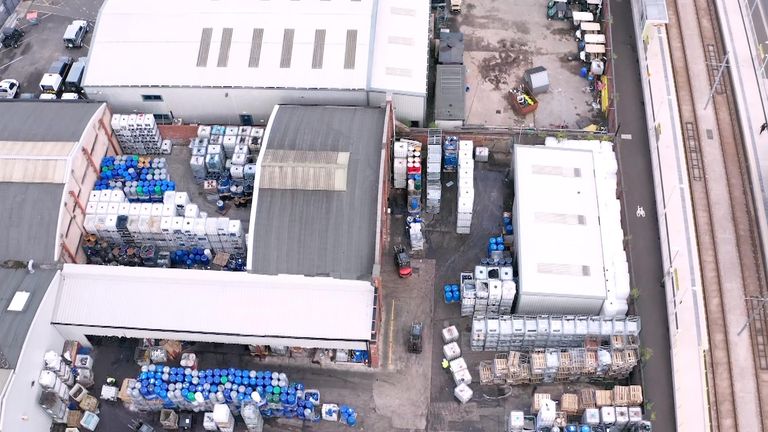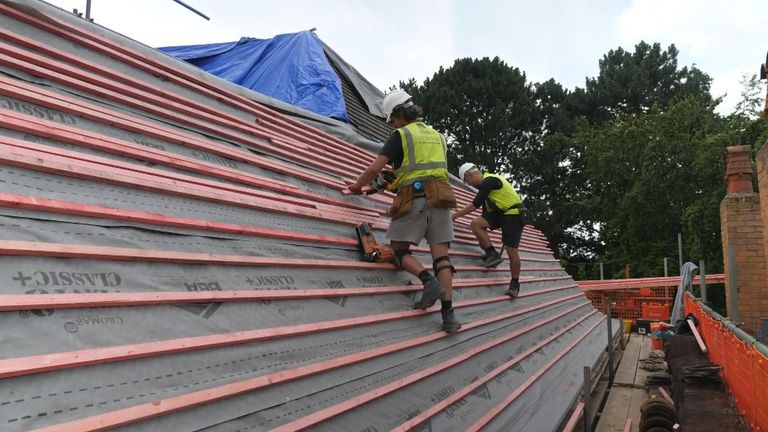Job vacancies are at their highest since records began – but why? | Business News
5 min readYou’d be forgiven for thinking that something a little weird is going on with the workforce at the moment.
We’re still coming out of a deep recession – one of the greatest economic shocks in modern times – parts of the economy such as the travel sector are still labouring under restrictions, and consumer confidence still isn’t what it was in some areas.
Usually you’d expect conditions like this to herald high unemployment, low job opportunities and squeezed wages. In short, a tough period for workers.
But instead data from the Office for National Statistics (ONS) today shows the exact opposite.
In fact, the number of job vacancies between May and June was the highest since records began in 2001 – nearly one million, easily topping what they were pre-pandemic and up a huge 43.8% on the previous quarter.
The number of employees on payrolls rose by 182,000 last month and wages have also been growing significantly.
What exactly is going on, and does this constitute some sort of golden age to be a worker?
The lack of staff is being felt in a variety of sectors. There’s been a lot of coverage about a chronic shortage in HGV drivers, while some food processing businesses have reported having to raise wages by as much as 10% to attract the staff they need.
In Emily Plunket’s business, she’s feeling it.
She’s head chef and director at Dinner Ladies, a food, events and catering company.
“It’s gone from sort of zero in the pandemic to a million events,” she says, “but you just can’t get the chefs”.
“For myself, hiring, sometimes I put up the price. If I’ve got a last minute job or something, you have to increase the salary, and because of the shortage, people are able to demand it.”
But bad news for her as a business owner is good news for some of the young chefs looking to work for her.
Victoria Pelham is one of them. She’s a new apprentice chef at Dinner Ladies, a job she found quickly and is starting on a good package.
“The pandemic definitely gave me a push,” she says. “There’s loads of places who are looking for chefs. And I feel like people are giving people more experience. Whereas before I felt like you had to go to a good culinary school, but I feel like people are maybe changing.”
The shortage in staff has certainly driven wages up too. Data for April to June show that wages excluding bonus grew by 7.4%.
Now, these figures do need to be treated with caution, there are statistical reasons they are so inflated. They are, for instance, being compared to a baseline of the same point last year when many more people were on furlough or on temporary pay cuts, while lots of lower earning jobs have been lost from the market skewing the average up.
But the ONS estimate that even when you adjust for these things there is still an underlying regular earnings growth rate of between 3.5% and 4.9%. Again, given we are supposedly emerging from recession this is not insignificant.
So why is this happening now?
Well, there are a few things going on. Firstly, there is a significant bottleneck of people all trying to get into the jobs market at once as varied parts of the economy all reopen at the same time. As part of that bottleneck there is also a mismatch between people and jobs, where workers’ backgrounds and training don’t necessarily match the openings that exist.
The pandemic has also inspired many workers to retrain, to perhaps move away from sectors like hospitality where they felt very vulnerable at the height of the crisis, while others have chosen to leave the workforce altogether.
And then there’s the furlough scheme. HMRC’s official statistics showed that as of May 31st, 2.4 million people were still on furlough.
The ONS estimates that number has fallen over the summer, but by late July some 700,000 to 1.2 million people were still using the scheme.
At this stage employers are having to contribute significantly to furlough workers, so experts expect many of them will return to their jobs. But even if this is the case, it’s still a large number of people not available to fill vacancies.
And finally Brexit has played a role too. Exact data for how many migrant workers have opted to go home is tricky to pin down but some estimates are that there are as many as half a million fewer people here.
So more jobs, more money and more opportunity – good news all round for workers?
Well perhaps for now, but experts don’t think it will last. Many predict the bottleneck effect will be relatively short term and while the number of vacancies is higher than before the pandemic, so is the number of people looking for work, so competition for the places will still be high.
When it comes to wages, many firms are expected to impose freezes on salaries, which as inflation takes hold will mean real terms pay cuts for many.
And then there are other shifts in the economy which don’t necessarily spell good news for workers.
“We’ve seen in certain sectors some really, really big firms thriving you can think of Amazons as the obvious example, but it’s been more general than that,” explains Robert Joyce, senior research economist at the institute for Fiscal Studies. “Very big firms thriving at the expense of smaller ones can be bad for workers because workers have fewer alternative employers to choose from and that tends to be bad for their bargaining power.”
But for now there are certainly positives to draw – not least a major incentive for employers to provide good packages and good conditions.
It’s something Michael Parinchy takes very seriously at his company proBuild 360. The firm brings in house every stage of the renovations they provide from the architects to the builders, they argue this has allowed them to pay above average wages and provide certainty to their workers.
“The security of knowing that there is work in the pipeline is something that people are looking for more than just cash in their pocket,” he says.
“People need to live. And if people are comfortable and happy in their life, because they’ve been paid properly, it reflects in their performance at work, [the high wages] are quite deliberate.”
The results he says is that he hasn’t been plagued with the shortages faced by many others in construction.
For all the negatives wrought by this pandemic, for companies, for now at least, it’s paying off to pay workers well.










